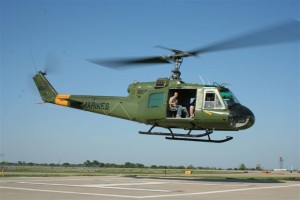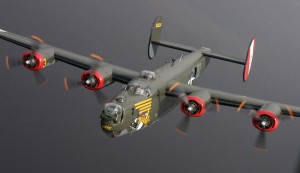
The Collings Foundation’s B-24J Liberator, Witchcraft, is the only restored, flying B-24J in the world.
By Clayton Moore
Visitors roaming New England might be a little surprised to discover an aircraft hangar nestled deep in the woods near the small town of Stow, Mass. The headquarters of one of America’s best-kept aviation secrets emerges from a misty forest so pastoral it might have been praised by Robert Frost, complete with a commanding view of a nearby lake, frozen in the winter chill. Nearby, a comfortable homestead supplements a rustic barn purposely built to house an astounding collection of vintage motor vehicles.
This impressive 70-acre complex is home to The Collings Foundation, a nonprofit educational foundation formed in 1979. The organization delivers its unique message about history and American heritage through an astounding collection of aircraft, race cars and other mechanized icons from the 1900’s century of invention.
The foundation’s best-known program and a major focus of its efforts is the Wings of Freedom Tour, a traveling showcase of World War II-era military aircraft that has made more than 2,000 visits to airports across America since it was started in 1989.
But the Collings Foundation finds many different outlets to spotlight the fascinating aircraft and vehicles in its Massachusetts collection. Paying tribute to its origins as a community-based organization, the Collings Foundation offers rare opportunities each year for visitors to experience “living history events” that draw thousands of delighted spectators.
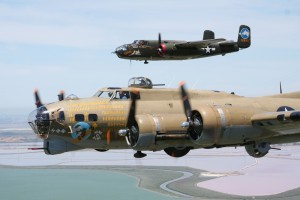
The Wings of Freedom Tour showcases two fully operational WWII bombers: the B-17G Flying Fortress Nine-O-Nine, seen in the foreground, and Tondelayo, a B-25 Mitchell.
At its most recent open house in October 2007, visitors from as far away as Europe came to tour the foundation’s collection and experience a dramatic reenactment of a WWII combat engagement. The demonstration, organized with the help of dozens of volunteers, included a rare flight of the German reconnaissance Fiesler Storch and a running battle between Nazi paratroopers and an American armored column.
This off-season facilities tour lent some insight into the deeply held educational philosophy behind the foundation’s extraordinary collection.
Off to the races
The visionary behind the foundation’s extraordinary holdings is Bob Collings, an entrepreneur and passionate automotive and aviation buff who shows no signs of slowing down as he approaches 70.
Collings made his fortune in the early 1970s with Data Terminal Systems, which manufactured the first stand-alone, electronic cash registers. Later, he co-founded Resource Dynamics Inc., a proprietary facilities asset planning and management system.
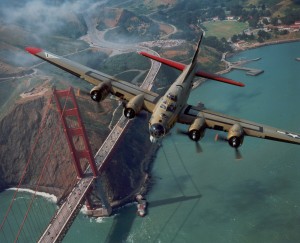
The Collings Foundation’s B-17 Flying Fortress has been restored to its wartime configuration and designated Nine-O-Nine in honor of a 91st Bomb Group, 323rd Bomb Squadron plane that completed 140 missions during World War II.
His entrepreneurial and financial success led him to acquire dozens of extraordinary automobiles. One thing led to another, and before long, he had the first hints of a proper museum collection on his hands.
“Really, it started with carriages,” explained Hunter Chaney, the foundation’s director of marketing, as he opened the doors to a converted barn that houses the Collings’ earliest acquisitions. “Then he went into automobiles, collecting more and more from each era.”
Today, the collection has bloomed to include some of the most historically significant pre-WWII American cars, as well as a sleek collection of notable race cars from the modern age. As his collection increased, Collings started seeking ways to manage it properly without incurring prohibitive expense. In 1979, the Collings family used its own money to launch a nonprofit 501(c)(3) foundation to organize the growing collection of historical artifacts under one umbrella organization.
“At that time, he had amassed most of the cars you see here today,” Chaney said as he surveyed the purpose-built garage facility dubbed “The Barn,” noting that the automobile collection is organized by era. “What we wanted to do was show a clear representation of the most popular models during any one period of time. We’re continuing to evolve the facility here.”

Founder Bob Collings narrates a re-creation of a pitched battle between German paratroopers and an American armored column, during his foundation’s Living History weekend in October 2007.
Three carriages from the 1800s and a sleigh from the early 1900s represent years before engines. The “Brass and Gas” era vehicles include turn-of-the-century rarities such as a 1904 Franklin Type A Roadster, 1913 Ford Model T Touring Car, 1914 Stutz Bearcat and two Stanley Steamers. A relatively small but equally impressive fleet represents the “Roaring 20s,” while the Classic Era includes gems like a 1927 Rolls Royce Springfield Phantom Phaeton, 1931 Studebaker President and 1932 Duesenberg FJ Duel-Cowl Phaeton in which automotive pioneer Fred Duesenberg suffered his fatal crash.
In an unfinished basement garage, an unrestored 1940 Cadillac Limousine V-16 seems unexceptional compared to the gleaming, hand-polished classics stored a floor above. Its historical significance becomes clear when it’s revealed that this particular Caddy was custom-built for a very special customer: the infamous Chicago mob boss Al Capone, who ordered the car in 1939 following his release from Alcatraz.
In the early days of The Collings Foundation, it focused on local and regional transportation-related events. The organization hosted antique car rallies, carriage and sleigh rides and an annual winter ice-cutting festival in Stow.
Once the foundation had the money and resources to expand its growing facility, the automotive collection grew to include some of the world’s most historic race cars. Housed in the upper decks of the foundation’s aircraft hangar are some of the world’s most famous cars, including a formidable assortment of sprint cars and midget racers dating from the 1920s to the 1950s, as well as several record-breaking sports cars.
Among the cars is a 1979 Porsche Indy, a factory race car that broke track records before it was banned; two winners of the 24 Hours of Daytona; and several Indianapolis 500-winning vehicles driven by such luminaries as Rich Vogler, Rick Mears and both Mario and Michael Andretti.
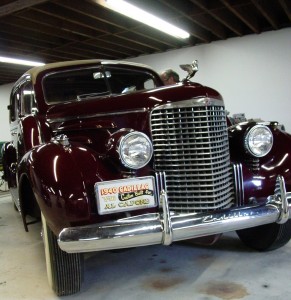
Nestled in the corner of an unfinished garage, this 1940 Cadillac limousine was built for notorious gangster Al Capone, who used the car upon his release from Alcatraz.
Another part of the hangar houses a fascinating fleet of trucks and farm vehicles, ranging from a 1909 Peerless Steam Tractor to a 1920s-era International Harvester, as well as a pair of sturdy farm trucks from the 1930s.
“You can’t have steam tractors of this type that are fully operational, because there’s a danger they’ll explode from the pressure that builds up when they operate,” Chaney explained. “We have it hooked up so we can get compressed air into it and show how it operates, but safely. This goes right along with everything else we do, in that we’re trying to show how major technological advancements happen.”
The point of having a working steam tractor, as it is with almost every item in this museum-quality collection, is to show it in action.
“Our educational philosophy came from Bob’s specific interests in presenting the collection in that light,” Chaney said. “You can see it from the start, with carriage rides and ice-cutting festivals. We just took that philosophy of experiential education, and we express it now through aviation and mobile transportation. The important thing is to have these machines be operational. It’s one thing to see things in a static display. To see an airplane, for example—to stick your head inside the cockpit, to touch the stick or even to take a ride in a barnstorming aircraft—becomes a much more tactile experience.”
Wings of Freedom
Shortly after forming the foundation, longtime aviation enthusiast Bob Collings was presented with a unique offer to buy a North American B-25 Mitchell bomber. He bought the aircraft and restored it to working condition. Along with other touring aircraft, the plane called Tondelayo is based and maintained in New Smyrna, Fla.
Another opportunity came knocking when an English aircraft collector put a 1944 Consolidated B-24J Liberator bomber on the market; it had flown a record 130 missions for the 8th Air Force. After buying the aircraft, Collings shipped the legendary WWII-era workhorse across the ocean before proceeding with an unprecedented restoration that utilized more than $1 million, 97,000 man-hours and detailed work on about 80 percent of the aircraft’s 1.2 million parts.
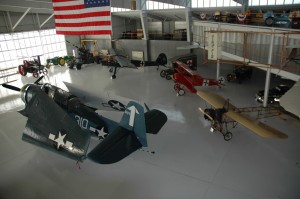
The Collings Foundation’s collections of automobiles and aircraft spans nearly 200 years of modern invention and fills a custom-built hangar in Stow, Mass.
“It took a couple of years to restore, bringing it to another location on a huge flatbed in multiple pieces,” Chaney recalled. “This is the only B-24J in the world still flying. It was originally intended for static display, but there was a huge groundswell of support to get it flying again, which sparked the Wings of Freedom Tour.”
Since its launch, the tour has been the major outreach effort of The Collings Foundation. The organization estimates that each year, between 3 million and 4 million people experience the warbird tour. In addition to the B-25 and B-24, the tour features the Boeing B-17G Flying Fortress Nine-O-Nine. Restored to its wartime configuration, the aircraft was named in honor of a B-17 of the 91st Bomb Group, 323rd Bomb Squadron that completed 140 missions during World War II.
To further its educational goals, the Collings team has also developed the Vietnam Memorial Flight, a touring company that includes a McDonnell F-4D Phantom II, Douglas TA-4J Skyhawk and Bell-UH-1E Huey helicopter. The aircrafts’ unique markings celebrate their combat histories. The Phantom is instantly recognizable to air combat enthusiasts, as it carries the markings of Brig. Gen. Steve Ritchie, the only Air Force pilot ace of the Vietnam War. The Skyhawk’s paint job signifies “The Playboys,” a distinguished all-volunteer group that operated out of Da Nang. The Huey has a combat history of its own and carries the markings it held when flown in combat by Capt. Steven Pless.
Other aircraft that make joint appearances at the annual events include a North American AT-6 Texan, Grumman TBM Avenger and Chance-Vought F4U-5NL Corsair, as well as several smaller aircraft from the collection in Stow.

A squadron of Nazi paratroopers takes fire from an American Chaffee tank and an armored Halftrack equipped with a .50 caliber quad machine gun, during a living history re-creation at The Collings Foundation’s headquarters in Massachusetts.
Chaney admits that the logistics of organizing such major events can be challenging.
“It’s like Chinese Checkers on a lot of different levels,” he laughed. “One stop in Florida will affect what we do four months down the line in Montana. We have a crew roster of pilots that rotate every month to six months, depending on the aircraft, and we have to coordinate mechanics, fuel, marketing and promoting each event. A lot of different things go into operating the tour.”
The tours’ most valuable assets may come from home. Bob Collings’ wife, Caroline, serves as the foundation’s chief executive officer and can be found working diligently in the foundation office, located upstairs, while their son Rob has become one of the region’s most dynamic sports drivers and pilots. The tour and other programs rely heavily on the younger Collings.
“Bob doesn’t fly, but his son Rob has grown into our chief pilot,” Chaney said. “He designates pilots, does all the training and conducts flight experiences. He was surrounded by all of this growing up and has become an incredible pilot.”
Rob Collings soloed at 16 in a Stearman biplane and got his jet certificate by age 17. He has more than 2,600 hours in the B-24 Liberator and more than 1,100 hours piloting B-17s. He’s also a rated driver for the International Motor Sports Association and Grand American Racing Series and has competed in the Grand-Am Rolex 24 Hours of Daytona and the American Le Mans 12 hours of Sebring. His wife, Caroline, has become a featured pilot on the tour.
“Caroline is the only woman in the world certified to fly a B-24,” Chaney said. “It’s an interesting bunch of family dynamics.”
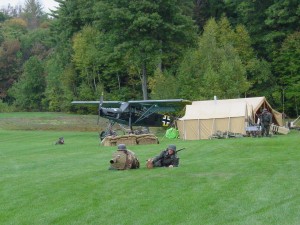
A fully equipped squadron of Nazi paratroopers (veteran re-enactors from the Living History Foundation) digs in behind a real Fiesler Storch reconnaissance aircraft during a recent event.
The Collings have recently integrated a unique, paid program that allows civilians to undertake flights in some of the foundation’s most fascinating aircraft. The program encompasses supersonic flights over international waters in the F-4 Phantom, type-rating flights in a Messerschmitt Me-262, demonstration flights in the TA-4 Skyhawk and even rides in the bombers featured in the Wings of Freedom Tour.
The Collings Foundation makes a dedicated effort to bring the tour to different parts of the country each year and plans unique events and activities tailored to the different locations. This year’s tour launched in February in Keystone, Fla., and stops are planned in communities from Alabama to California.
“We want to bring this interactive traveling museum to communities that might not otherwise experience it,” Chaney said. “At certain locations, we’ll do some special events. In San Francisco, we’ll do ‘real’ bomb drops on a range—dropping dummies of course—showing that these planes are operational. On the East Coast, we’ll have original radio operators from World War II come out and speak again over our newly operational radios. They’re very unusual pieces of machinery, with technologies that are long past their due dates. We’re trying to provide a memorable lesson from history; that’s what the Wings of Freedom Tour is all about.”
Growing wings
Collings began his collection with the bombers, fighter planes and other aircraft that have become regular features on the Wings of Freedom Tour, but the collection quietly housed in Stow could match the country’s finest aviation museums in its breadth and quality.
With an annual operating budget of about $4 million, its private funding includes donations, memberships from the organization’s nearly 50,000 supporters and fees garnered from aircraft appearances and rides. To its credit, the foundation has completed restoration projects faster than many major aviation museums around the country.
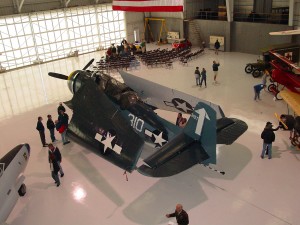
A TBM Avenger torpedo bomber awes some visitors, while others enjoy a roundtable by World War II veterans at the open house.
“We’re more self-sufficient than a lot of institutions of this type,” Chaney admitted. “We don’t do a lot of aircraft loans, other than exchanges, but there has to be a lot of networking just to keep the planes flying. A lot of what is here has been acquired, traded or donated.”
Among the most interesting items are the pre-WWII aircraft. They’re smaller than the impressive warbirds housed on the hangar floor but are no less historic in their importance.
Early aviation buffs will instantly recognize the 1909 Bleriot XI, a more developed version of the famed powered airplane aviation pioneer Louis Bleriot flew across the English Channel in 1909.
“This is really what started the whole craze of flying,” Chaney said. “Imagine if I told you in 1909 that I could float three feet off the ground. You’d think I was crazy, because it’s just too fantastic an idea. When Louis Bleriot started making planes like this one, it allowed well-to-do commoners to buy them, kit-style, and learn to fly. It made flying accessible to the general population in many ways. Before this airplane, people were building kite-like gliders with propellers that looked like something out of a storybook. This is the birth of aviation—the birth of modern flying—in many ways.”
Another early aircraft is a replica 1911 Wright Vin Fiz, which was renowned in its time as the first aircraft to cross the American continent with Calbrath Perry Rodgers at the controls. It was one of the first flights with corporate sponsorship, supported by the makers of a grape drink called “Vin Fiz.” Unfortunately, Rodgers’ triumph was short-lived.
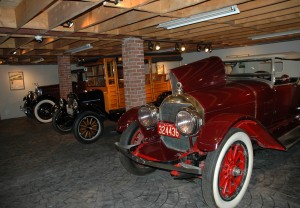
In a custom-built garage dubbed “The Barn,” The Collings Foundation maintains a priceless collection of antique cars from different eras in American automotive history.
“We were going over the math on this trip not too long ago,” Chaney said. “This was the equivalent of an $11 million sponsorship, which was huge money for a company at that time. The pilot crashed about every other stop, so a train covered in Vin Fiz logos would follow him across the country. He would crash, and they’d come out with their carpentry equipment, fix up the plane, pat him on the head and send him off for another 20 miles. He made it all the way to the other side of the United States before he crashed and died.”
WWII, the Korean War and the Vietnam War aircraft represent the remainder of the collection. Among the WWII aircraft housed in Stow are a Boeing PT-17 Stearman, Cessna UC-78 Bobcat and the formidable Grumman TBM Avenger.
“It’s a monster of an airplane,” Chaney said of the Avenger. “It’s impressive when this aircraft takes off from our little grass strip outside, because it’s difficult to imagine something this large taking off from so short a space.”
Military vehicles and other tools include a Ford Jeep, a German 88mm antiaircraft cannon and a 1943 M16 Halftrack that plays an important role during newly launched military re-creations. American Aero Services restored the Halftrack in Florida. Its fully operational quad .50 cal turret, modified with a propane fired “movie cannon” system, simulates the vehicle’s real firepower.
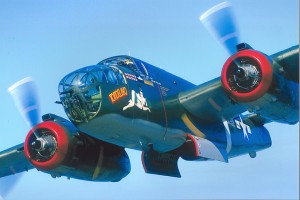
The Collings Foundation’s North American B-25 Mitchell was restored in 2001 as Tondelayo, representing a famous B-25 that flew in the Fifth Air Force’s “Air Apaches” in the Pacific Theater.
From the German side, the foundation’s Fiesler Fi-156 Storch originally flew for the Luftwaffe. Once used for forward air observation on battlefields, it too makes regular appearances during the annual events at the Stow facility.
Living history
Although the museums at The Collings Foundation’s headquarters are beautifully maintained and impressive, they remain mostly private, simply because the logistics of opening them to the public are too daunting. However, the foundation generously opens the facility several times a year to host groups ranging from Scouts to veterans. On average, the facility hosts 25 events per year, many of them fundraising events for nonprofits.
The Collings Foundation has also traditionally held an annual open house on Father’s Day, offering demonstration flights and tours of the facility. Last year, it added a living history open house, Oct. 6-7.
That event featured a reenactment that portrayed a skirmish between Allied Forces and a German encampment. The German response came complete with a reconnaissance flight by the Fiesler Storch, piloted by Rob Collings, and a group of reenactors from the WWII committee of the local Living History Association, representing Nazi paratroopers from the German 914th Regiment. After a heated battle, the paratroopers retreated with a group of American soldiers in hot pursuit. The reenactors were led by Chaney, firing the .50 caliber machine gun from the Halftrack, backed up by an M24 Chaffee light tank.

One of the most recognizable aircraft of the Vietnam era, the McDonnell Douglas F-4 Phantom is a key element in The Collings Foundation’s Vietnam Memorial Flight.
“That particular reenactment was the first of its kind on this side of the United States,” Chaney said. “When the tank rolled up, the audience was awestruck. We had some reservations about doing this kind of re-creation, because of its portrayal of violence. We’re not trying to glorify violence; we want to educate visitors about the time that is being portrayed. That’s where history is important. As much as we learn from our successes and use them as a platform for greater accomplishments, we also have to look at the things we did wrong. We hope that by people truly understanding certain times in history, they can use that knowledge as a basis for future decisions.”
Bob Collings, who narrated the event and explained the particulars of the fictional battle for visitors, affirmed that the foundation’s events are intended to memorialize, not politicize, American history. He said his organization promotes the idea of people being able to participate in history: seeing, touching and feeling it.
The drawing power of the collection has surprised even its caretakers from time to time.
“When we started, we were just doing open houses, but now it’s really blossomed into events where a lot more participation from other groups is possible,” Chaney said. “Events like this are really starting to catch on with the public. This year’s event drew 3,000 visitors per day, including people from England, Italy, Finland and other European capitals. Of course, when you have attractions like the ones here at The Collings Foundation, it’s hard to go wrong.”

Another aircraft featured in the Vietnam Memorial Flight, this Douglas TA-4J Skyhawk has been repainted with the markings of “The Playboys,” a distinguished all-volunteer fast forward air control group that operated out of Da Nang.
The foundation has a unique event planned for later this year that will utilize both its aviation and automobile collections and will put Bob and Rob Collings on performance in equally amazing machines. The father-and-son team is planning a “Race of the Century” between competing technologies from different eras, pitting a finely tuned automobile against a “new-fangled” contraption, the airplane.
“It’s a way for us to talk about how people transitioned through various forms of transportation and finally into flying,” Chaney explained. “What we hope to do is start with a horse-drawn carriage and talk about the major transportation routes all through New England. Then we’re going to race the carriage against the Stanley Steamer to see who wins.”
The race between the elder Collings, driving a progressive selection of the foundation’s automobiles, and his son, in its early aircraft, will progress until visitors get to see a 1914 Stutz Bearcat put to the test against Bleriot’s danger-fraught kit plane.
“These are technological advancements that happened at the same general time,” Chaney said. “It’s a competition of technologies between driving and flying. It should be an interesting race.”
Other events will feature actors in period costume portraying Bleriot as well as famous aviatrix Harriet Quimby, the first licensed female pilot in the U.S. The foundation also makes a concerted effort at each event to honor and give access to the veterans who make its mission possible.
“The generation who lived through World War II is quickly passing,” Chaney said. “When you speak with someone with firsthand experience of the most major events in American history, it changes your perspective to a huge degree. In a matter of years, people will no longer have the opportunity to interact with WWII veterans in this kind of setting. It adds urgency to what we’re doing.”
Despite the diversity of their outreach programs, the people behind The Collings Foundation never forget their many supporters, past and future.
“It’s important for people to realize that when they come out to see these aircraft and tour them and fly in them, they become, in essence, the very people who are keeping them flying,” Chaney said.
For more information about The Collings Foundation and the Wings of Freedom Tour, visit [http://www.collingsfoundation.org].












